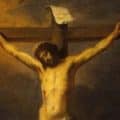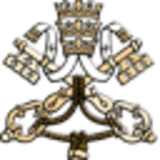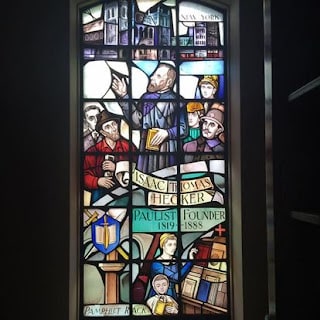Among the many wonderful things which one can watch nowadays on YouTube, there is a series of videos from the Italian TV coverage of the coronation of Pope Saint John XXIII on November 4, 1958. Several times during that lengthy ceremony, the choir chants Jesus’ words which we just heard in today’s Gospel: Tu es Petrus, et super hanc petram aedificabo ecclesiam meam (“You are Peter, and upon this rock I will build my church”). Also, that Gospel account was chanted, not once but twice – first by a Latin deacon, and then by a Greek deacon. I think that’s what is called making a point!
Today’s feast and its Gospel take us back in time – from the baroque splendor of St. Peter’s Basilica and the modern papacy to the region of Caesarea Philippi and to Peter himself. Caesarea Philippi was situated some 20 miles north of the Sea of Galilee in territory ruled by King Herod’s son Philip, hence the name. That place is now known as « Banias, » a deformation of its pre-Roman name, « Paneas, » referring to the Greek god Pan. At the time of Jesus, a fertility cult was thriving in the pagan temple to Pan at this location at Israel’s northern border at the foot of Mount Hermon. That border was obviously a lot easier to cross in Jesus’ time, than it is now; but it was still a border, laden with symbolic spiritual significance.
It was to that faraway, pagan place that Jesus took his disciples and asked them what is, in some sense, still the basic Christian question: Who do you say that Jesus is? As befits the prominent role he is being prepared for, Peter answers on behalf of the disciples – on behalf of the entire Church: You are the Christ, the Messiah, the Anointed One, the Son of the living God. Not only does Peter proclaim that Jesus is Israel’s hoped-for Messiah, but – in that site sacred to Pan, the son of Zeus – he proclaims Jesus as the Son of the living (that is, the one true) God.
Then, as now, Peter speaks for the Church –for all of us. In response, Jesus assures us that Peter’s profession of faith is not just another opinion, one option among many in the global religious marketplace, but a revelation from God – one which Peter himself still probably at best only poorly understood. From such a modest beginning in such an oddly out-of-the-way place, Peter’s profession of who Jesus is, has been the center of the Church’s proclamation – as Peter’s role has since likewise remained central to the Church’s identity and mission.
Fast forward to the baroque basilica built above Peter’s tomb, where Peter continues to speak – on the Church’s behalf for the sake of the whole world. In a Church that right now, as so often in her past, seems much more divided than united, the papal office continues to serve as a visible source of the unity of the Church across space and time. Across space, “people of every nation, culture, and tongue” (as we say in the Eucharistic Prayer) are “gathered as one,” so that “in a world torn by strife and discord,” we “may stand forth,” as a Universal Church, “as a sign of oneness and peace.” Such a unity across space is, in turn, uniquely possible because of the Church’s unity across time – our unity with Peter in his profession of faith in the Christ, the Son of the living God, whose own victory over death has definitively guaranteed that the gates of the netherworld shall not prevail against the Church.
Homily for the Feast of the Chair of Saint Peter, Cathedral of Saint Andrew, Grand Rapids, MI, February 22, 2024.





